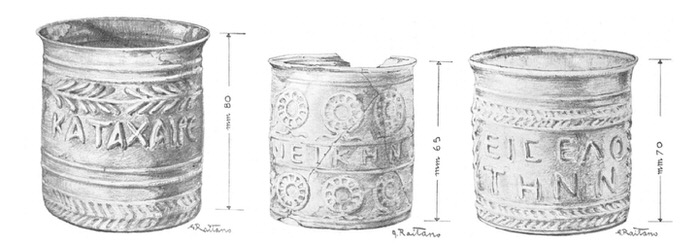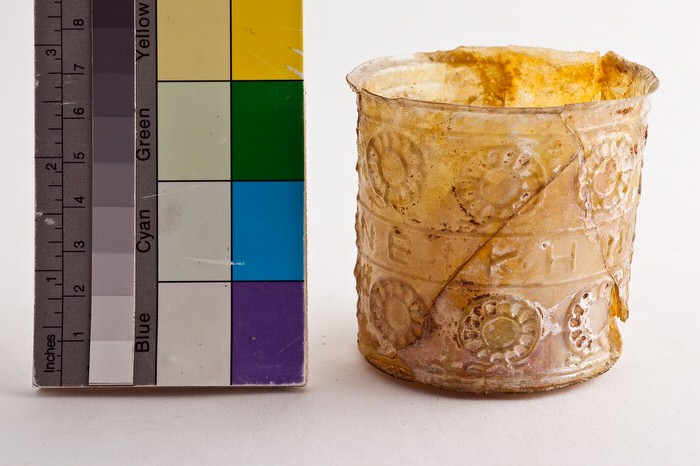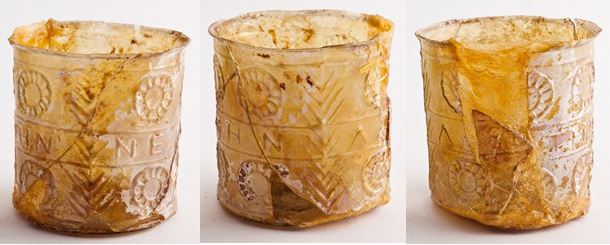Glasses with inscription
Three mould-blown cylindrical glasses with inscription in Greek come from the Roman necropolises in the Cornus area, surveyed in the XIX century; their production is Near-East (fig. 1).
The three examples all date I A.D. and have the same formal characteristics but are different in decorations and writing.

The first glass has an inscription that translates as "rejoice and enjoy"(fig. 2) on its light yellow straight side and the decoration has palm branches, ribs in relief and a band of continuous leaves. The example was probably made from the same matrix of a second found in Jerusalem. Those items were produced in the second half of the I century A.D., in the areas of Lebanon, Palestine, Cyprus and Syria.


In the second example (fig. 3), the inscription translates as «take the victory» and has concentric circles with a ray pattern on its sides. It has been ascertained that the Cornus glass originated from the matrix also used for an example conserved in the Louvre, also produced in Cyprus.


On the third item (fig. 4) the Greek text incites with the phrase «entering, take the victory» in drinking competitions and is between two palm leaves. The glass item can be compared with only another two examples both conserved in the Louvre: one found in the Crimea and the other in Syria. The three examples come from a single matrix.

This type of glass seems to have been produced in Sidon, in Lebanon. But other shops must also have been active in the Syrian-Palestinian and Cypriot area. It is possible that, initially, these items were only exported to the various markets of the Roman empire. But later, due to the artists themselves emigrating to areas where demand was massive, they were made far from the East.
Bibliografia
- G. BEVILACQUA, R. D’ORIANO, Exotica come segni del potere: un thymiaterion cnidio da Olbia, in M. B. COCCO, A. GAVINI, A. IBBA (a cura di), L’Africa romana. Trasformazione dei paesaggi del potere nell’Africa Settentrionale fino alla fine del mondo antico. Atti del XIX Convegno di studio (Sassari, 16-19 dicembre 2010), I-III, Roma 2012, II, pp. 1943-1958.
- G. BORGHETTI, I vetri romani da Cornus conservati nel Museo Nazionale di Cagliari, in AA.VV., L'archeologia romana e altomedievale nell'Oristanese. Atti del Convegno di Cuglieri (22-23 giugno 1984) = Mediterraneo tardoantico e medievale, Scavi e ricerche, 3, Taranto 1986, pp. 83-89.
- G. BORGHETTI, D. STIAFFINI (a cura di), I vetri romani del Museo Archeologico Nazionale di Cagliari, Oristano 1994, pp. 26-27, 78-79.
- G. BRUNN, Vasi di vetro con iscrizioni, in Bullettino archeologico sardo, X, 4, 1864, p. 12.
- G. CARA, Monumenti di antichità di recente trovati in Tharros e Cornus, esistenti nel R. Museo di Cagliari, Cagliari 1865, pp. 43-44.
- S. CIAPPI, I vetri di Palazzo Pitti dai Medici di Savoia, Firenze 2014, p. 144-145.
- CUGLIERI I = AA.VV., L'archeologia romana e altomedievale nell'Oristanese. Atti del Convegno di Cuglieri (22-23 giugno 1984) = Mediterraneo tardoantico e medievale, Scavi e ricerche, 3, Taranto 1986.
- A. D’ALESSIO, S. LUPPINO, Vetri iscritti da Copia Thurii. Ultimi bagliori di una città dei Bruttii, in A. COSCARELLA (a cura di), Il vetro in Italia: testimonianze, produzioni, commerci in età basso medievale. Il vetro in Calabria: Vecchie scoperte, nuove acquisizioni (Università della Calabria, Aula Magna 9-11 giugno 2011), Arcavacata di Rende 2012, pp. 353-370.
- M. T. FORTUNA CANIVET, I vetri romani di Cornus, conservati al Museo di Cagliari, in Journal of Glass Studies, XI, 1969, pp. 19-26.
- D. B. HARDEN, Romano-Syrian Glasses with Mould-Blown Inscriptions, in The Journal of Roman studies, 25, 1935, pp. 163-186.
- A. MASTINO, Cornus nella storia degli studi con un catalogo delle iscrizioni rinvenute nel territorio del comune di Cuglieri, Cagliari 1984, pp. 138-140.
- M. C. MCCLELLAN, Recent Finds from Greece of First-Ceentury A.D. Mold-Brown Glass, in Journal of Glass Studies, XXV, pp. 71-78.
- M. PUDDU, Scheda RA_00163375 - Reperto Archeologico (su ICCD 3.00). Sistema Informativo del Patrimonio Culturale della Sardegna (R.A.S), pp. 1-7.
- G. SPANO, Quantità di vetri che si trovano nei sepolcri, in Bullettino archeologico sardo, VIII, 7, 1862, pp. 110-112.
- G. SPANO, Storia e descrizione dell’antica città di Cornus, in Bullettino archeologico sardo, X, 4, 1864, pp. 113-119.
- G. SPANO, Memoria sopra alcuni idoletti di bronzo trovati nel villaggio di Teti e scoperte archeologiche fattesi nell'isola in tutto l'anno 1865, Cagliari 1866, p. 118.
- G. SPANO, Memoria sopra una moneta finora unica di Nicolò Doria e scoperte archeologiche in tutto l'anno 1867, Cagliari 1868, pp. 34-35.
- G. SPANO, Scoperte archeologiche fattesi in Sardegna in tutto l'anno 1871, Cagliari 1872, pp. 22-24.
- E. STERN, Tree Notes on Early Roman Mold-Blown Glass, in Journal of Glass Studies, XLII, pp. 165-167.
- A. TARAMELLI, Cuglieri. Ricerche ed esplorazioni nell’antica Cornus, in Atti dell'Accademia Nazionale dei Lincei. Notizie degli scavi di antichità, 15, pp. 285-331.
- A. TARAMELLI, Edizione archeologica della carta d'Italia. Foglio 205, Capo Mannu. Foglio 206, Macomer, Firenze 1935, pp. 182-185.

 VR
VR